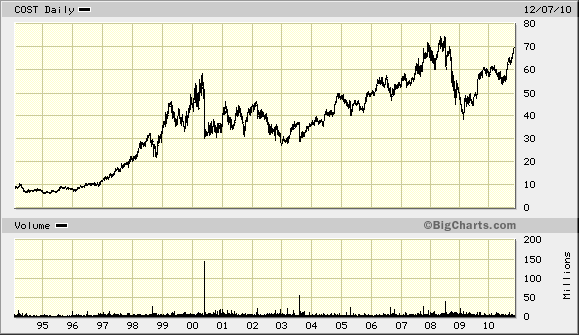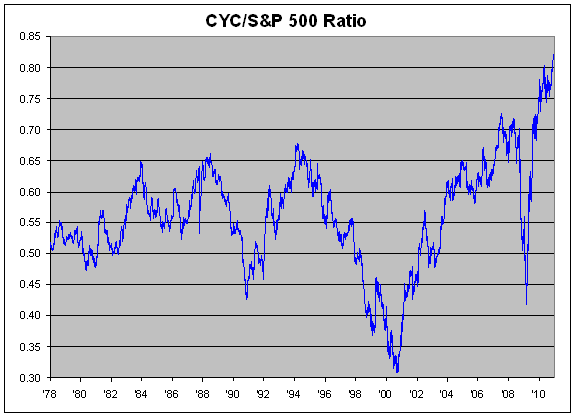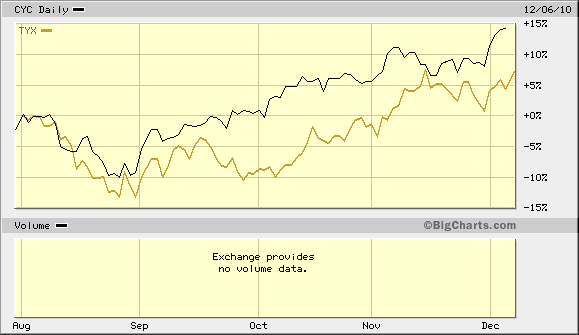Archive for December, 2010
-
The New Yorker’s John Cassidy on China and Trade
Eddy Elfenbein, December 8th, 2010 at 11:57 amIn this week’s New Yorker, John Cassidy writes about China and state capitalism. The article is only for subscribers, but here’s some audio of Cassidy discussing the piece.
-
What Wikileaks has on BofA
Eddy Elfenbein, December 8th, 2010 at 11:25 amThe Onion has the story:
* TARP bailout funded the Men’s Warehouse spree needed to restore confidence in the company
* List of employees who have generously contributed to executive Catherine P. Bessant’s Bank of America fun run, employees who have not
* Whenever CEO Brian Moynihan needs to buy a cup of coffee, he takes a few dollars from a random customer’s account
* CFO Charles Noski has had to have the concept of interest explained to him eight times since being hired
* There is nothing in the Bank of America vaults excepts bones of poor people
* Tellers have been secretly cramming 51 cents into each roll of pennies to try and get rid of them all
* Executives attempted to cover up a video showing a Bank of America helicopter strike on squatters in a Tampa-area foreclosed home
* During the October 2008 collapse, then-CEO Ken Lewis proposed removing lollipops from lobbies to cut costs
-
Costco Posts Good Earnings
Eddy Elfenbein, December 8th, 2010 at 11:15 amShares of Costco (COST) have been in a blistering rally since last August. This is probably a good indication of the strength of the consumer (or at least, employed consumers).
The stock recently broke $70 per share. It reached its all-time high in May 2008 at $75.23. Today this company reported decent earnings. The company earned 71 cents per share which was two cents more than the Street was expecting. Margins continue to expand as profits rose by 17% while sales rose by 11%.
Costco has lifted sales since the recession by luring bargain-hungry consumers to pay for membership, which lets shoppers and small businesses buy discounted goods including groceries and televisions. Membership increased 3.6 percent to 58 million in the year through August, and fee revenue rose 10 percent to $416 million last fiscal quarter.
“The quarter continued the theme of modest gross margin expansion, strong membership fee growth and execution on curtailing expenses,” Brian Sozzi, an analyst for Wall Street Strategies Inc. in New York, said in a note to clients.
Costco fell 46 cents, or less than 1 percent, to $69.18 at 10:13 a.m. New York time in Nasdaq Stock Market trading. The stock rose 18 percent this year before today, while competitor BJ’s Wholesale Club Inc. gained 44 percent. Wal-Mart Stores Inc., the world’s largest retailer and operator of wholesaler Sam’s Club, climbed 3.1 percent in 2010.
Membership Fees Up
Costco’s gross profit, or income after cost of goods sold, as a percentage of total revenue rose to 12.9 percent from 12.8 percent. Selling and administrative costs as a portion of revenue dropped 0.2 percentage points.
Sales at stores open at least a year, excluding fluctuations in gasoline prices and currency exchange rates, rose 5 percent, Costco said. Sales advanced 10 percent at the company’s 157 stores outside the U.S. and 4 percent at its 425 locations in the U.S. and Puerto Rico.
Total revenue, including membership fees, rose to $19.2 billion from $17.3 billion a year earlier, the company said. Analysts predicted $18.8 billion, the average of 16 estimates.
In many ways, this story is a like a microcosm of the broader economy. The earnings report is good and Costco’s stock has performed well over the past several months, but it seems like the margin-expansion story is hitting a wall. Gross profit margins aren’t even expanding any more, and SG&A can only be cut so much.
The message is clear: For Costco and others to continue to grow, they need to see top-line growth. More sales means more consumers which means more employed consumers.
-
Morning News: December 8, 2010
Eddy Elfenbein, December 8th, 2010 at 7:43 amU.S. Stock Index Futures Mixed; Eyes on Bonds
Tax Deal: Rich Aren’t the Only Ones Who Benefit
EU Banks Reportedly Face Further Stress Tests
Bullish Commodity Bets Sustained Near Four-Year Peak, Data Show
Euro Slips as Debt Worries Persist
U.S. Fiscal Health Worse Than Europe’s: China Adviser
Gasoline: $3 by Christmas and a ‘Mini-Apocalpyse’ in Spring?
Bank of America Deal in Muni Case May Be `Tip of the Iceberg’
Jim Beam Maker Fortune Brands to Split in Three After Ackman Builds Stake
Citigroup Shares Rise After Bank Escapes U.S. Fetters
Costco Wholesale First-Quarter Profit Gains 17% on Gasoline, Grocery Sales
-
From One Month Before the Bottom
Eddy Elfenbein, December 7th, 2010 at 10:31 pmHere’s a blast from the past. This is from February 9th, 2009. I’m waiting for these two to grovel before Jon Stewart and be cheered on by the White House.
-
It’s a Cyclical World
Eddy Elfenbein, December 7th, 2010 at 4:46 pmThe rest of us are just paying rent.
I know I’m sounding like a broken record, but consider these numbers: The Morgan Stanley Cyclical Index (^CYC) has now outperformed the S&P 500 for nine-straight sessions, 13 of the last 14 and 21 of the last 25.
Since March 9, 2009, the CYC has outperformed the S&P 500 by a ratio of 256% to 81%.
-
The Gold/Silver Ratio
Eddy Elfenbein, December 7th, 2010 at 3:39 pmBespoke Investment Group posts the Gold/Silver ratio going back to 1975:
They note that the ratio has tended to bounce between 40 and 80 over the past few years. The ratio is now down to 47.
The Gold/Silver Ratio is a topic that has obsessed people for centuries. Plato mentioned that the Gold/Silver ratio was 12. In 1792, the U.S. Congress, at the advice of Alexander Hamilton, passed the Coinage Act of 1792. This was the government’s first attempt at price-fixing. The act defined a U.S. dollar as 371.25 grams of silver or 24.75 grams of gold. In other words, Hamilton pegged the Gold/Silver ratio at 15. In 1834, Congress had to bump it up to 16.
-
The One Chart That Explains It All
Eddy Elfenbein, December 7th, 2010 at 1:20 pmI probably oversold this post with that title, but this chart will tell you a lot about what’s going on. Here you see the yield on the 30-year Treasury bond moving somewhat closely with the Morgan Stanley Cyclical Index (^CYC).
In other words, investors are taking on more risk. They’re leaving the safety of Treasury bonds while simultaneously raising the value of cyclical stocks.
What’s also happening is that the Volatility Index (^VIX) is falling. The VIX fell to 17.13 today. It was close to 50 in May.
Does this contradict the chart? I don’t think so. While the risk preference of investors is rising, the implied volatility is falling. These are two risk measures, but they don’t necessarily measure the same thing. “Risk” is one word we use for many different developments. My guess is that the lower volatility reading reflects that investors are more locked into the current trend and is not a judgment of what that trend is.
-
The 2011 Buy List Announcement
Eddy Elfenbein, December 7th, 2010 at 12:21 pmI’m going to unveil the Buy List for 2011 next Friday, December 17.
The new Buy List will go into effect at the start of trading on Monday, January 3, 2011.
I make each Buy List publicly known about two weeks before the end of the year so no one can claim that I fudge the numbers or front-run the stocks.
As usual, once the Buy List is set, I can’t make any changes for the entire year.
I plan to add and delete five stocks which is just one-quarter of the portfolio.
-
S&P 500 Breaks 1,230
Eddy Elfenbein, December 7th, 2010 at 10:48 amWall Street seems to like the tax deal, or at least stocks are rallying after that specific news has come out. The media loves to say that the market did X in response to event Z, but we can never be sure that Z was the cause of X.
The S&P 500 broke 1,235 this morning which is its highest intra-day point in over two years. The market, however, has backed up some since then. Several of our Buy List stocks are doing well. Fiserv (FISV) is at a new 52-week high. Becton Dickinson (BDX) is inches from a new high. Moog (MOG-A) also hit a new high this morning.
Interestingly, gold plunged $20 per ounce within a few minutes this morning.
The CEO of Bank of America (BAC) said that the bank plans to raise its dividend next year. He said they’ll target 30% of earnings which will probably be 40 cents per year, or 10 cents per share per quarter.
The old quarterly dividend got as high as 64 cents per share before it was slashed to just one penny per share.
-
-
Archives
- April 2025
- March 2025
- February 2025
- January 2025
- December 2024
- November 2024
- October 2024
- September 2024
- August 2024
- July 2024
- June 2024
- May 2024
- April 2024
- March 2024
- February 2024
- January 2024
- December 2023
- November 2023
- October 2023
- September 2023
- August 2023
- July 2023
- June 2023
- May 2023
- April 2023
- March 2023
- February 2023
- January 2023
- December 2022
- November 2022
- October 2022
- September 2022
- August 2022
- July 2022
- June 2022
- May 2022
- April 2022
- March 2022
- February 2022
- January 2022
- December 2021
- November 2021
- October 2021
- September 2021
- August 2021
- July 2021
- June 2021
- May 2021
- April 2021
- March 2021
- February 2021
- January 2021
- December 2020
- November 2020
- October 2020
- September 2020
- August 2020
- July 2020
- June 2020
- May 2020
- April 2020
- March 2020
- February 2020
- January 2020
- December 2019
- November 2019
- October 2019
- September 2019
- August 2019
- July 2019
- June 2019
- May 2019
- April 2019
- March 2019
- February 2019
- January 2019
- December 2018
- November 2018
- October 2018
- September 2018
- August 2018
- July 2018
- June 2018
- May 2018
- April 2018
- March 2018
- February 2018
- January 2018
- December 2017
- November 2017
- October 2017
- September 2017
- August 2017
- July 2017
- June 2017
- May 2017
- April 2017
- March 2017
- February 2017
- January 2017
- December 2016
- November 2016
- October 2016
- September 2016
- August 2016
- July 2016
- June 2016
- May 2016
- April 2016
- March 2016
- February 2016
- January 2016
- December 2015
- November 2015
- October 2015
- September 2015
- August 2015
- July 2015
- June 2015
- May 2015
- April 2015
- March 2015
- February 2015
- January 2015
- December 2014
- November 2014
- October 2014
- September 2014
- August 2014
- July 2014
- June 2014
- May 2014
- April 2014
- March 2014
- February 2014
- January 2014
- December 2013
- November 2013
- October 2013
- September 2013
- August 2013
- July 2013
- June 2013
- May 2013
- April 2013
- March 2013
- February 2013
- January 2013
- December 2012
- November 2012
- October 2012
- September 2012
- August 2012
- July 2012
- June 2012
- May 2012
- April 2012
- March 2012
- February 2012
- January 2012
- December 2011
- November 2011
- October 2011
- September 2011
- August 2011
- July 2011
- June 2011
- May 2011
- April 2011
- March 2011
- February 2011
- January 2011
- December 2010
- November 2010
- October 2010
- September 2010
- August 2010
- July 2010
- June 2010
- May 2010
- April 2010
- March 2010
- February 2010
- January 2010
- December 2009
- November 2009
- October 2009
- September 2009
- August 2009
- July 2009
- June 2009
- May 2009
- April 2009
- March 2009
- February 2009
- January 2009
- December 2008
- November 2008
- October 2008
- September 2008
- August 2008
- July 2008
- June 2008
- May 2008
- April 2008
- March 2008
- February 2008
- January 2008
- December 2007
- November 2007
- October 2007
- September 2007
- August 2007
- July 2007
- June 2007
- May 2007
- April 2007
- March 2007
- February 2007
- January 2007
- December 2006
- November 2006
- October 2006
- September 2006
- August 2006
- July 2006
- June 2006
- May 2006
- April 2006
- March 2006
- February 2006
- January 2006
- December 2005
- November 2005
- October 2005
- September 2005
- August 2005
- July 2005





 Eddy Elfenbein is a Washington, DC-based speaker, portfolio manager and editor of the blog Crossing Wall Street. His
Eddy Elfenbein is a Washington, DC-based speaker, portfolio manager and editor of the blog Crossing Wall Street. His